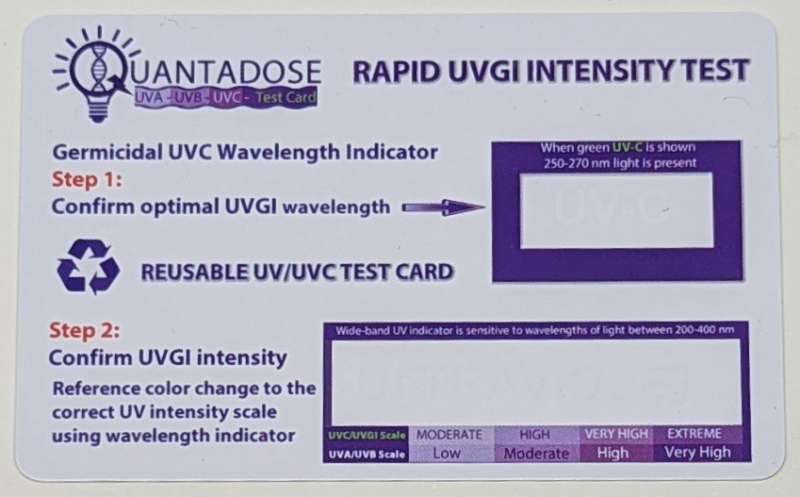
REVIEW – Have you ever been curious about whether your UV sterilization devices are using real UVC light to kill germs? I have. Since you can’t see UVC light, I sought out an inexpensive way to test for this and found a website that said you can use a Quantadose Rapid UVGI (ultraviolet germicidal irradiation) Intensity Test card. The card is inexpensive and reusable. I found that it successfully detects the presence (or absence) and intensity of UVC light in my UV sterilizing devices.
What is it?
Quantadose Rapid UVGI Intensity Test card is a plastic card containing two test areas that will react when exposed to UV light. The reaction of both areas will determine whether or not you have a device using UVC light.
Design and features

When I received the Quantadose Rapid UVGI Intensity Test card, it was the only thing in the package. It is a plastic card and is the same size, weight, and thickness as a credit card making it easily portable and accessible.
First of all, we should define the commonly used terms “sterilization”, “disinfecting”, and “sanitizing”. According to the Healthline website,
-
- “…sterilization removes all microorganisms — including those that aren’t harmful. Sterilization is common in medical facilities…”
- “…disinfecting removes harmful organisms from objects”
- “…sanitizing aims to lower the amount to a safe level. The process of sanitizing can involve both cleaning and disinfecting.”
Next, to understand how the card worked, I needed to go to the Quantadose website.
Using the Quantadose Rapid UVGI Intensity Test card to detect UVC and its intensity
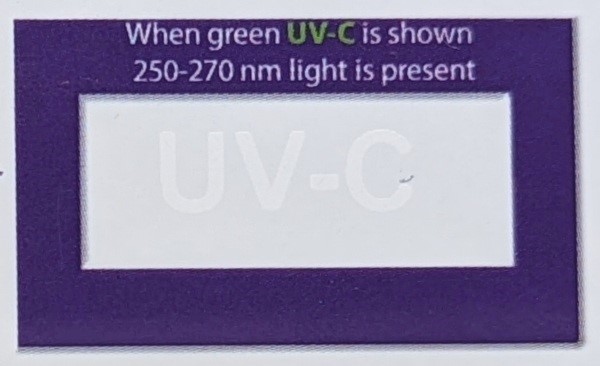
Step 1 of the card: The “Step 1” box of the card (shown above) contains the letters “UV-C”. When UVC light (222-280 nm wavelengths) is absorbed in this area, the letters fluoresce green. It stops glowing the instant the UVC light is no longer present. According to the Quantadose website, Step 1 is just an indicator that UVC light is present. It does NOT tell you if the intensity is high enough to sterilize.
Step 1 of the card works by using a substance that absorbs UVC energy which excites electrons in that substance causing them to jump to a higher energy level. When the electrons fall back to their original level, they release the extra energy in the form of visible light around 515 nm (green wavelength), thus causing the “UV-C” letters on the card to fluoresce green.
All genuine properly functioning UV-C 253.7 nm Mercury Bulbs, Excimer Lamps producing FAR-UV 222nm or UV-C 200-280 nm, and Microcavity Plasma Bulbs emitting 222 nm FAR-UVC will all ALWAYS display bright green UV-C letters…
The color that Step 1 emits is only relative to green photons under any UV-C irradiation conditions; however, just like mixing colors of paint, mixing colors of light as these photons reach your eyes will change the original color perception. (Quantadose website)
Quantadose also explains that the Step 1 “UV-C” area will fluoresce over and over indefinitely and thus can be used indefinitely.
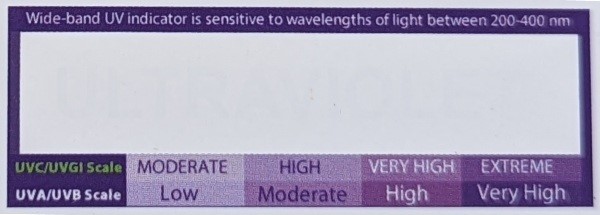
Step 2 of the card: Step 2 of the card “…uses a very wide-band photochromic test area that relies on calibrated word power visibility (WPV) starting [at] > 300 µW/cm² when the word ”ULTRAVIOLET” first becomes legible [when] exposed to optimal UV-C germicidal wavelengths.” In other words, when the intensity of the UVC light reaches 300 µW/cm² (the intensity necessary to sterilize), you will be able to read the word. If you can’t see the word, the UVC light is not intense enough to sterilize.
To achieve sterilization, you need a UVC light source to deliver a certain amount of total energy based on the intensity of UVC light provided for a certain amount of time over a given surface area. You also need to consider what kind of material you are sterilizing, how far from the UVC source the material is, etc.
Before the pandemic, 100 mJ/cm² was a standard UVC dose in the healthcare industry for disinfecting pre-cleaned hard surfaces in rooms to assist in a greater log reduction of infectious agents. This 100 mJ/cm² is still acceptable for non-porous surfaces like most pre-cleaned plastics, metals, and glass. (Quantadose website)
The above quote addresses the UVC dose required to sterilize hard non-porous surfaces. You need even more of a UVC dose to sterilize porous surfaces like clothing. The Quantadose card is a good starting point to determine if your UVC sterilization device has the potential to sterilize.
If the card confirms you have adequate intensity (> 300 µW/cm²), then it will take 333 seconds (5 minutes 33 seconds) to reach a total energy of 100 mJ/cm². This is determined by dividing the energy (Joules) by the power (Watts; Watts = Joules/s).
Quantadose mentions that although you can reuse the “Step 2” area many times, it has a limit. The cumulative effect of high-energy UV degrades the photochromic test material – not the number of times you use the card. They suggest limiting the exposure of this area to 15 seconds to get up to 500 uses out of it and storing it away from UV light sources when not in use.
Performance
Tests on devices known to use UVC and UVA
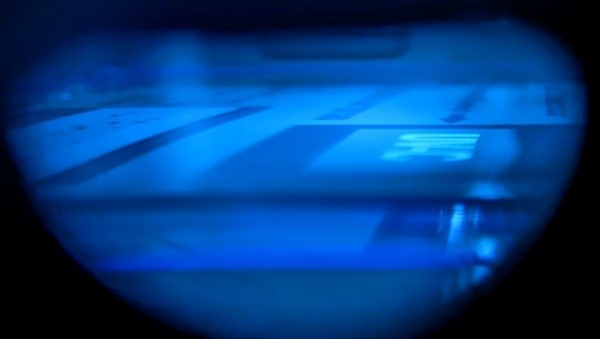
Using the Quantadose card in a device that is known to use UVC: I used the Quantadose card on my PhoneSoap Go which I know uses UVC light and has sufficient UVC light intensity to sterilize our phones (see the PhoneSoap Go smartphone UV-C sanitizer review where I used agar Petri dishes to test for the presence of bacteria and mold on our phones before and after being cleaned by the PhoneSoap).
As you can see in the above photo, the “UV-C” letters are glowing green, thus detecting the presence of UVC light.
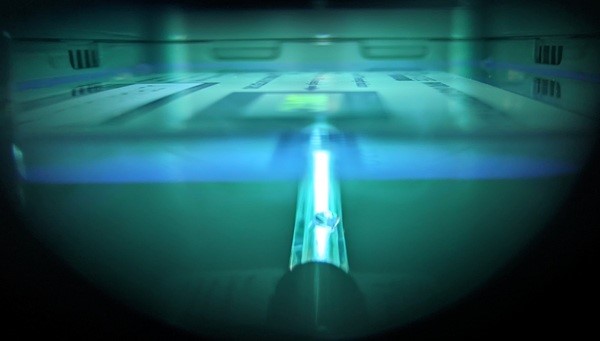
The above photo illustrates the relative size and intensity of the UVC light bulb in the PhoneSoap.
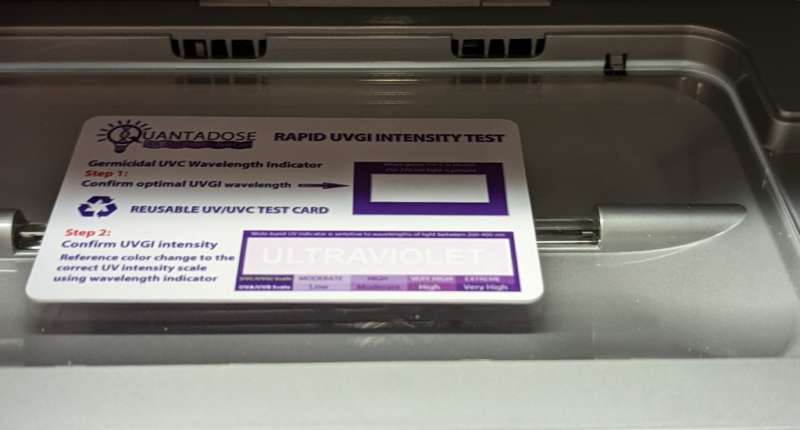
You can see from the photo above that you can read the word “ULTRAVIOLET” on the card. The intensity was even greater than what is shown above because it took me a few seconds to take the picture after opening the lid (the color on the card starts to fade after about three seconds).
Thus the PhoneSoap Go has a UVC light with enough intensity to sterilize our phones. This corroborates my positive findings on the germicidal effects of the PhoneSoap Go (see the PhoneSoap Go smartphone UV-C sanitizer review).

Using the Quantadose card on a known UVA light source: The above photo illustrates a test using a UVA flashlight (395 nm wavelength). The “UV-C” letters do not glow green but the “ULTRAVIOLET” letters are revealed. Taken together, these results mean that the card has only detected UVA and not UVC and that the UVA light intensity is high to very high.
Test on a device that claims to use UVC
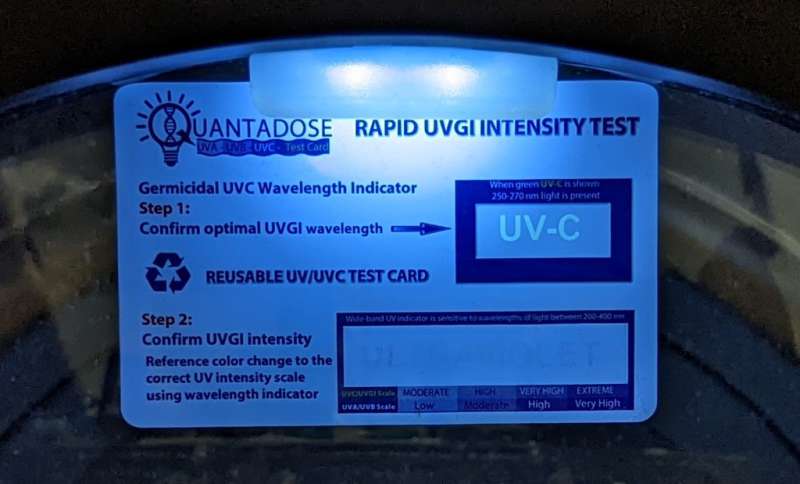
Using the Quantadose card with the Morus Zero dryer: I recently reviewed the Morus Zero portable clothes dryer which claimed to use UV to sterilize clothes. So, I tested each of the Morus Zero’s drying modes for the presence of UVC light. (These results below come from my Morus Zero dryer review).
When I placed the card within a centimeter of the dryer’s light and ran the dryer using each of its modes, the card detected the presence of UVC on two of the eight modes: the Sanitize and Refresh modes. You can also just barely read the word “ULTRAVIOLET” when it detected the UVC light.
Since clothes don’t dry within one centimeter of the light and the intensity of UVC light drops off the farther away you get from the UVC LED, I needed to place the card in different areas of the dryer where the clothes would tumble to see if the UVC light was intense enough in those areas to sterilize them.
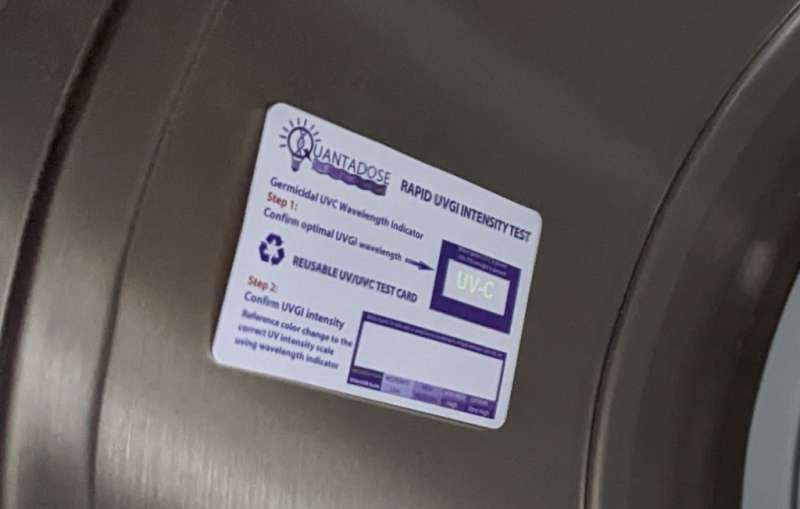
When placing the card in the center of the dryer using the Refresh mode for 6 minutes, it detects the UVC light, but since you can’t read the word “ULTRAVIOLET”, the intensity is not enough to sterilize your clothes.
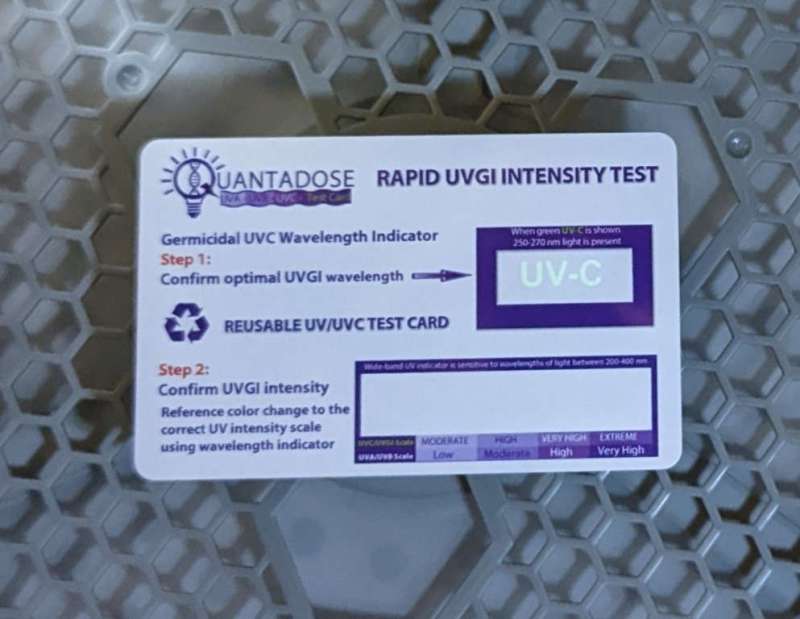
And when placing the card at the back of the dryer for a few minutes, again it detects the UVC light but the intensity is not enough to sterilize your clothes.
It’s also important to note that for UVC to sterilize an object, all parts of the object must be directly exposed to the light. Much of the surface areas of the clothes placed in the Morus Zero are not in direct contact with the UVC light and are thus not being sterilized.
There’s even more to this card than what I’ve talked about. For instance, the “UV-C” letters can fluoresce different colors (yellow or blue) depending on the mix of UV light.
However, since I don’t have any mixed UV light sources that would result in different fluorescent colors, I can’t verify those aspects of the card. However, if I ever get anything that does, I will update this review.
What I like
- It’s simple to use
- It’s reusable
- It’s inexpensive
What I’d change
- The card is perfect but the Quantadose website is quite cluttered with information; it needs organization
Final thoughts
I loved using the Quantodose Rapid UVGI Intensity Test card. It is easy to use, inexpensive, and reusable. By placing the card in the presence of the UV light being tested, you can quickly determine if the UV light is UVC or not. If the “UV-C” letters fluoresce green, this indicates the presence of UVC light. And if you can see the word “ULTRAVIOLET”, the UVC intensity is enough to provide germicidal effects.
I highly recommend this card to determine if your UV sterilization products are actually using UVC light or not.
Price: $12.10
Where to buy: Amazon or Walmart
Source: I purchased the Quantadose Rapid UVGI Intensity Test card with my own funds.


![[Strong Magnetic Lock]:Built-in magnets, offering a magnetic force of up to 3000g. Ensures the magnetic wallet fits tightly and attaches securely to the back of your iPhone. [Smart Card Storage]:The magnetic wallet is designed ingeniously to hold 5 c...](https://m.media-amazon.com/images/I/41i8zbilqXL._SL160_.jpg)
Gadgeteer Comment Policy - Please read before commenting
Great reporting! I have a couple of PhoneSoap Gos which I was pretty sure work as advertised. The one device of which I am dubious is unfortunately too small to check with this card: a 1.5″ square toothbrush cap that claims to disinfect – but since its light-on time is only 3 minutes that seems suspect even without checking the alleged UVC light.
Betty – Ah, that is a problem (testing your toothbrush sterilizer). Perhaps you can cut the card so that the individual step 1 and step 2 test boxes fit in the sterilizer?
I did exactly that! And found that while the toothbrush sterilizer DOES emit UVC light, it is far too weak to do anything in the 3 minutes it is on.
Betty – Cool!! Thanks for reporting your findings!! What toothbrush sterilizer do you use?
Unvia – I got it heavily discounted during The Grommet’s going out if business clearance so figured worth a shot. Manufacturer link:
https://www.uvnia.com/toothbrush
Betty – thanks for the info and I’m sorry to hear that the UVNIA sterilization device didn’t have the intensity necessary to do the job. I wonder if any of them do? If it fits, I suppose you might be able to place your toothbrush (or toothbrush head if it is an ultrasonic toothbrush) in your Phonesoap Go to sterilize it. I use my Phonesoap Go to sterilize my mouth guard.
Neat review! I have several UV sterilizers, but I always worry that they don’t work. Thank you.
Tim – I’m glad the review helped! ☺️
What a wonderful review that answered many questions I had about the product! I hope you will review their newest test card too. https://www.amazon.com/QuantaDose%C2%AE-Multi-Wavelength-Bi-Luminescent-Far-UVC-Light/dp/B0BK1772JY/
John – I’m so glad that you found the recipe helpful! Thanks for leaving a comment!
I didn’t realize that Quantadose came out with a new card. Thanks for the heads-up! I’ll give it a try sometime in the near future and let the Gadgeteers readers know what I find!
*review, not recipe 😆
How i can buy the card in Netherlands?
Nader – That’s a good question – I’m not sure. I was going to suggest contacting Qunatadose to find out, but I couldn’t find an email address or phone number for them, (their website looks unfinished). But, you can purchase a Quantadose card from Amazon. I found this website that tells you some of the ways you can do that:
https://borderoo.com/pages/does-amazon-ship-to-norway-yes-heres-the-solution/
I hope this helps!
I had a UV-C lamp installed in the air duct of my furnace during COVID. It’s been 2 years and the installer says the bulb is no good anymore and wants to sell me a new bulb. I then used my Quantadose card and it indicated the UV-C bulb was still good “and” sterilizing effectively. Some internet sites say a bulb is only good for about a year; some other sites say the bulb can be effective as long as it’s on and working. Who should I believe?
Ron – I’m not an expert on UVC bulbs so I don’t know the answer to your question.
I did some quick research online to see if I could find some information about this. The HVAC industry seems to follow a guideline that the bulbs they use (possibly mercury bulbs?) decrease in germicidal UVC light efficiency by about 15% per year. I haven’t yet found studies that confirm this. However, I found some info about how the mercury UVC bulbs work in a water sanitizing system:
“A UV lamp, however, operates on a different principle, more like a fluorescent light. In this case, the electricity is still passed through a tungsten filament which heats up, but that energy “excites” the mercury vapor contained in the lamp. (Not to worry, only a very small amount of mercury is used, typically <10 mg, and it’s safely contained.) In this case, it is the mercury vapor that glows and, emits ultraviolet (UV) light. This is exactly what’s needed to inactivate any pathogens in your water supply. As you may know, UV light is not visible to the naked eye and is, in fact, quite damaging, so never look directly at a UV lamp while it’s on. If your system has a view port, you may see a blue glow from the lamp, but that’s not a result of the UV rays. Remember, UV light cannot be seen by the human eye. This glow is simply a by-product of the lamp’s operation.
The useful life of the UV lamp is determined by the rate at which the mercury is consumed. That very small amount of mercury contained in the lamp will provide sufficient UV rays to disinfect the water for about one year. After that, although the lamp appears to be working, there is not enough UV produced [to sanitize]”
From my brief look at the info online, there are many factors that impact the germicidal efficacy of UVC bulbs in HVAC situations: the type of bulb used (there are different types like mercury and LED bulbs), air flow rate, the humidity (water can absorb or reflect the UVC and decrease germicidal efficacy), the wall temperature of the mercury bulb (it works most efficiently at 40 degrees C so there is a wind-chill effect where air blowing over the bulb effects how efficiently it works), etc.
I guess if I were in your position, I would follow the guidelines of the company that sold you the bulbs to make sure that the bulbs do what you want them to do. One article I read, said that as the efficiency of the bulb decreases, eventually it won’t be very effective at killing microbes but will continue to use electricity. So you’ll be paying to continue to operate the bulb, but it won’t be killing microbes.
I don’t have any UVC bulbs in my HVAC system, so your doing better than me!
I hope this info helps!
Thank you so much for the information on sanitizing a water system (my question actually pertains to a forced air system). However, I’m still puzzled because the Quantadose card says if “the intensity of the UVC light reaches 300 µW/cm² (the intensity necessary to sterilize), you will be able to read the word.” Since I can clearly and strongly read the word “Ultraviolet” then the bulb should be working. If not, is it possible that the card has a serious flaw (a false positive)?
I finally spoke to someone at Quantadose. They agreed that UV-C bulbs will indeed lose some effectiveness or simply burn out over time. However, if the Quantadose card indicates that the bulb is working effectively enough to sterilize then that time hasn’t come yet. Perhaps the original installer also believes I should change the oil in my car every 3000 miles (just kidding). Thank you so much Kathleen for your help.
Ron – I provided the info about UVC lamp in a water system because it gave a good summary of how a UVC lamp works (some might believe that if you see the light on, it is still sterilizing which may not be the case).
You tested your UVC lamp using the Quantadose card in your HVAC unit, and the card was stationary when exposed to UVC light. Since your question covers a forced air system, I was primarily concerned about the amount of time that the moving air is exposed to UVC. My guess is that the more efficient the UVC lamp is (the newer it is), the less time moving air must be exposed to UVC light to kill microorganisms.
If however, you are only using the UVC lamp to disinfect coil/surfaces (stationary items) of your HVAC system, then it makes sense to me that you would follow what the Quantadose card says.
If you are interested in more info, the following links provide some additional information and interesting data:
https://www.amca.org/educate/articles-and-technical-papers/amca-inmotion-articles/uv-c-for-hvac-air-and-surface-disinfection-2.html
https://www.ashrae.org/file%20library/technical%20resources/covid-19/i-p_s20_ch17.pdf
https://www.ncbi.nlm.nih.gov/pmc/articles/PMC7571309/